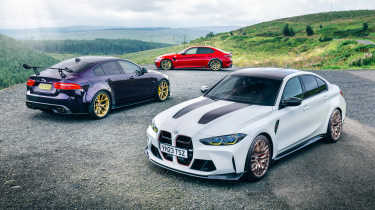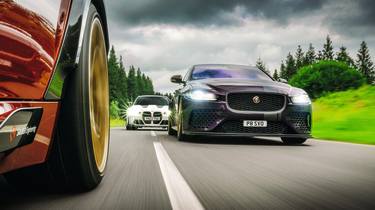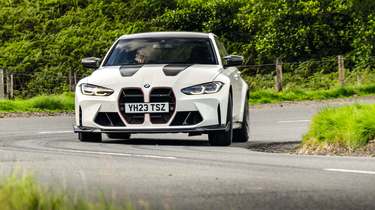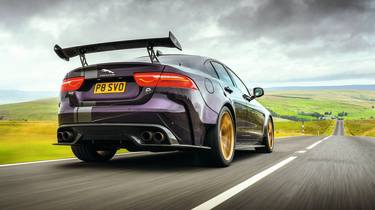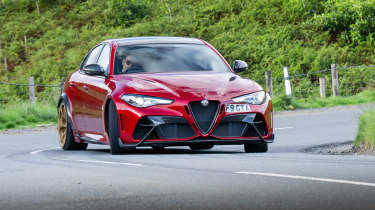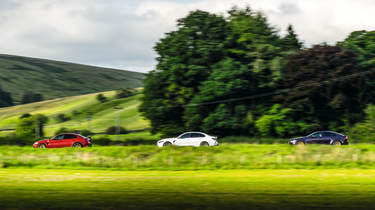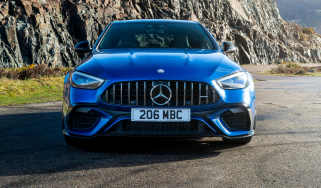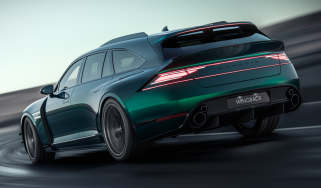BMW M3 CS v Alfa Romeo Giulia GTA v Jaguar XE Project 8 – supersaloon specials go head-to-head
BMW’s M3 CS is so dazzlingly good that a regular head-to-head seemed inadequate. Instead we pit it against two icons, Alfa Romeo’s sublime Giulia GTA and Jaguar’s awesome Project 8
Sometimes it’s about more than pure dynamics. Sometimes star power overwhelms everything. I guess we hadn’t thought of that when we lined up the ultimate test for the new M3 CS. It seemed reasonable enough. Those two letters – CS – have come to take on real significance. The E46-generation M3 CS set the template: small, considered tweaks to deliver a huge upswing in entertainment, control and excitement. When the title was revived for the F82 M4 CS and F80 M3 CS, the M division dramatically smoothed away the spikiness of the standard cars whilst simultaneously improving precision. Then came the M2 CS, a thoroughly deserving eCoty winner. Followed by the M5 CS, another eCoty champ, an instant classic and a car that radiates a magnetic, menacing personality.
So, when we heard about the new M3 CS, expectations were zinging off the rev-limiter. One of those old M rev-limiters starting with an 8. A simple head-to-head with, say, the new C63 AMG didn’t seem sufficient. Instead, we went big and rarefied. We looked for saloon cars transformed with proper hardware upgrades and a single-minded focus. It was a great plan in an office building, but in the cold light of a chilly morning in Kielder Forest, the potent M3 CS looks strangely out of its depth.
> Alfa Romeo Giulia GTAm (2021 - 2022) review: if Porsche built a four-door 911 GT3 RS
Our great friend Harry Metcalfe has arrived in his ‘Engorged Penis Purple’ Jaguar Project 8 and it looks, well, very intimidating. What a fantastically overblown saloon car shape! Even before the supercharged 5-litre V8 begins to bellow, the P8’s gaping intakes, razor-edged carbonfibre sills, radically extended but then cut away rear arches and steeply raked rear spoiler could hardly shout any louder. I love the unequivocal aesthetic, and beneath the skin Jaguar’s skunkworks supersaloon is just as mission-obsessed. This is so much more than an exercise in cramming the biggest engine available into the littlest body in the range. By comparison the sabre-toothed BMW just seems lumpy and a bit goofy.
The Alfa Romeo Giulia GTA is positively demur as it sits in the shadow of the P8. And yet it seems to have its own spotlight shining down from on high. Talk about star power. Although this four-seater version of Alfa’s highly specialised saloon car loses the dramatic hooped rear wing of the GTAm, the detailing is exquisite, the attention to detail stunning and the proportions, outrageously gorgeous centre-lock wheels and slivers of carbonfibre aero addenda combine into a whole that’s nothing short of sinful. I can’t think of another saloon car that looks this desirable. From any era. I just want to hop in and disappear into the forest, never to return.
Part of the reason we could prepare such a hostile welcome party for the M3 CS is that it’s a thoroughly engineered upgrade over the already brilliant M3 Competition xDrive. Another part is the price. The CS costs from £115,900 and this car, fitted with carbon-ceramic brakes, sits on the road at £123,250. Not only is that vastly more expensive than the regular Competition model (£84,070) but it starts to reach for the limited-edition Project 8, which was £149,995 when new and is available for less on the used market, and the GTA, which was £157,750 new and begins in the same ballpark used. For a regular series-production BMW M3 it’s a big number to swallow. There will be no caveats in this test for the M3’s lower price point, that’s for sure.
Rewind to the previous evening, and the BMW and I close in on the hotel in the dead of night. At least it feels that way. Maybe Google Maps knew the next couple of days would be all about discovering if this new model builds on the CS dynasty, because the route claws and scratches across the most testing of roads. Up here in the Scottish Borders the dark is different, too. It’s barely 9pm but there are no other cars; dim street-lights in the occasional village don’t carry a millimetre past the next derestriction sign, and the road’s unpredictable path is mostly a mystery, even with the M3’s brilliant headlights on full beam. Photographer Aston Parrott has already sent a picture of his first crisp beer from the hotel bar; inspiration enough to try to make significant progress. I do love the little twinge of nerves as you plunge into a forest, feeling like the only human on this path.
The headlight trace of the CS seen from above would be pretty impressive, I think. And fast-moving. In these situations you need a car with easily accessed performance and stubborn body control that can shake off any surprises hiding just beyond the range of what’s visible. The CS has those qualities in abundance. As ever, the twin-turbocharged straight-six delivers in a torrent, but one that’s so easy to direct and measure out. The top-end madness can wait for daylight, of course, but surfing along on the incredibly potent seam of torque in the upper reaches of the mid-range is a thrill all of its own. Travelling so quickly but knowing there’s much in reserve heightens the sense of awe.
It’s more than matched by the grip, balance and poise of the chassis. We’re familiar with the M3 Competition xDrive’s deep-seated composure, but the CS noticeably ticks everything up a few notches. The slightly heavier steering responds even more accurately, the ride is firmer but wheel control in particular is exceptional and the grip and traction available are pretty astounding. It unravels the secrets of this incredibly challenging road with ease but I don’t want to use the word ‘effortless’ – there’s a sharpness and raw energy to the CS that goes well beyond that. The limit is out there somewhere, I’m sure, but it’s nice to know the CS is something pretty special even when it’s operating well within itself. And that it doesn’t tie itself in knots on UK roads that would be an M4 CSL’s worst nightmare.
That was then and today is a new day, though the memory is reassuring. It’s safe to say, however, that the M3 CS doesn’t win the beauty contest at our gathering point. Did I mention how plain stunning the GTA looks? Nor does the BMW possess the wanton aggression of the Jaguar Project 8. But these roads don’t care too much for that stuff. Star power be damned if either is left toiling in the wake of the CS.
It seems unlikely that’s going to happen in the case of the Project 8. Quite aside from the raw numbers – 592bhp at 6500rpm, 516lb ft from 3500-5000rpm, top speed of 200mph – the level of detail that went into this SVO project is bordering on the ridiculous. Harry was working with the team at the time and knows every detail intimately. There’s a story behind each decision and very often a struggle to get every upgrade signed off. That’s a lot of struggles…
The Project 8’s suspension was radically overhauled, with unique knuckles machined from billet, split front wishbones with a shim system to allow for greater camber control, a new rose-jointed rear upper arm assembly and new anti-roll bars. It retained Jaguar’s Continuously Variable Damper system, but there are adjustable spring platforms to create two ride height settings – Road and Track – and there are helper springs at each corner. Harry has his car wound down to Track, which he says ups control and doesn’t appear to hurt the ride quality. It’s still possible to select Comfort, Sport and Track for the dampers.
There’s much, much more, and listing every change would require a feature in itself, but just a few choice ingredients give further insight into the work that went into Project 8. The front track is wider by 24mm, the rear by 73mm; carbon-ceramic brakes save 18kg, the carbonfibre bonnet a further 3kg; the front splitter can be extended 60mm and, in combination with the rear wing in high-downforce mode, produces 122kg of downforce at 186mph (V‑max in this configuration). Every panel bar the roof and door skins is changed, too. The four-wheel-drive system is retuned and sends a maximum 30 per cent of torque to the front wheels; there’s a rear e-diff and torque vectoring by braking on both axles. In other words, the Project 8 should be able to handle an M3 with a 39bhp bump and mildly tweaked suspension.
Sensations come thick and fast in the Jaguar and it’s a very different experience to the CS. I love the simple sweep of the dash and the low scuttle, the perfectly round and thin-rimmed steering wheel and the rich sensations that come humming back through it. This, more than anything, is where the Jaguar scores over the M3. There’s just more feedback, an even better sense of what’s happening beneath the big 265-section front Cup 2 tyres, while the accuracy afforded by bespoke suspension components is tangible every time it carves cleanly towards an apex. The sheer scale of the V8 soundtrack somehow makes the P8 feel a physically bigger car than the M3 (it is a little wider, but shorter and lower) but there’s no questioning its agility and the appetite it shows for sustained g loads as it steers sweetly from one corner to the next without requiring a moment’s pause to settle and control its mass.
The near-600bhp engine shrugs off 1745kg and is a living entity all on its own. Perhaps the M3’s 542bhp straight-six has a bit more nuance and subtlety. A little more light and shade. However, the pure theatre and knock-out punch of the supercharged V8 is tough to beat. The eight-speed automatic gearbox is solid but a slight disappointment in the context of the motor, delivering decisive changes but lacking the fully lit feel of the rest of the car. For that’s the overwhelming impression left by the Project 8. Everything about it marries exaggeration with a tenacious accuracy. So often, shouty V8s and blistered, swollen bodywork are used to distract from a dynamic repertoire that’s big on brute force but actually rather blunt beneath the surface. The Project 8 balances shock and awe with an inherent sharpness that’s captivating.
Yet it takes just a couple of miles for the Alfa GTA to expose weaknesses. It comes down to balance and damping. Where the Jaguar rattles on corrugated tarmac, the GTA glides, and despite a four-wheel-drive system that’s supposedly rear-biased, the Project 8 never displays any real adjustability at road speeds. It’s all grip, all traction and a gentle scrub into understeer should you ever breach the limits of the Michelins. By comparison the rear-driven GTA is incredibly multi-faceted, opening up new layers as time and distance pass, and immersing the driver more and more deeply in the experience. It’s a vastly different approach and one that is apparent immediately. The GTA (A for Alleggerita or lightened) weighs 1605kg – 140kg less than the Jaguar and 160kg less than the 1765kg M3 CS – and the car’s philosophy celebrates that concept. It feels so alert, so nimble.
Just like the Project 8, the GTA is vastly different to the car on which it’s based. The 2.9-litre twin-turbocharged V6 delivers 533bhp at 6500rpm, just 30bhp up on the unit in the Giulia Quadrifoglio, but it features lighter con rods, new cooling jets for the pistons and lighter turbines for the blowers, too. The track, front and rear, is increased by 50mm, in part thanks to wider centre-lock rims, and the Sauber aero kit features an active front splitter, side skirts, unique rear wing and carbonfibre rear diffuser. There are also new springs, dampers and bushings and standard-fit ceramic brakes. The ‘lightened’ part is evident from the carbonfibre bonnet, roof, front bumper, front and rear wheelarch extensions, the carbon propshaft and a host of other small changes, saving 15kg over the Quadrifoglio despite everything that’s been added (the GTAm increases this to 40kg).
I suppose the difference is that Alfa Romeo’s starting point was an already super-sharp and entertaining M3 rival rather than an accomplished ‘executive saloon’ (do we still use that term? I used to read it a lot in Autocar in the 1990s). The GTA is built lower and leaner than the Jaguar or the M3, that’s for sure. You feel as if you’re sitting way down low and instantly connected to the road. The interior isn’t wildly different to a Quadrifoglio’s and doesn’t feel as high quality as the BMW’s, but there’s no question it’s more evocative, more exotic.
The way it gets down a road is more exotic, too. From the light and incredibly fast steering to the free-spinning V6 – which revs with a smoothness way beyond that of the Quadrifoglio – and the on-the-nose balance, the GTA has an awful lot of Ferrari vibes. This is a very good thing indeed. We are eternally grateful to owner Mark Shaw for the loan of his car and although this version of Alfa’s ultimate super-saloon may still have rear seats and do without the high-rise rear wing, it feels a pure sports car to its very core. Sweet, precise, wickedly fast and happy to take the strain with smooth inputs but with another dimension available to the driver should they want to really get stuck in.
On roads that rush fast across a valley floor, the GTA is a riot. It’s stable through sweepers, snicks through hairpins, and when you can commit to, say, an open third-gear corner it teeters right on the edge with delicious harmony. All four tyres share the load, and as the car builds a tiny slip angle but remains fully hooked up, that engine seeking out the limiter again, the GTA really does dazzle. Push beyond this lovely plateau and there’s easily gathered oversteer on demand and, here on the road, the fragile rear diff never causes an issue. This car isn’t perfect – the ceramic brakes are much better than the Quadrifoglio’s standard items but still have longer travel and relatively abrupt bite, for example – but it’s deeply, endlessly entertaining.
For me the only real negative is a strange one. Even in Race mode the GTA lacks vertical body control. It’s an extremely supple car, the Alfa, and we suspect the set-up is adjusted from the two-seater GTAm model (details on this car are very hard to ascertain as it was launched into the black hole of Covid). This is definitely a part of its appeal, but there’s certainly scope for another damper setting that locks everything down with more consistency. Too often it will float over a big crest and then freeze as it hits the bumpstops before reasserting control. I usually hate cars that exhibit this behaviour, so the fact that I’m so enchanted by the GTA speaks volumes for its other qualities and its sheer force of personality. Right now, last night’s drive in the M3 CS is but a distant, foggy memory.
The poetic end to this story is that the CS romps in, takes on the aggression, grip and pure cross-country performance of the Project 8 and the interaction and breathtaking agility of the GTA to move the game on to new heights. But, as ever, the truth is more complex than that. One thing I should say is that the CS is much more than ‘an M3 with a 39bhp bump and mildly tweaked suspension’ as I stated so disparagingly earlier. In fact, the journey travelled to reach CS status is reminiscent of that of its rarefied competitors here. Aside from raising boost pressure from 1.7 bar to 2.1 bar and the fitment of a 4kg lighter titanium rear silencer, the CS also features stiffer engine mounts, bespoke geometry, specific springs and dampers plus helper springs, new anti-roll bars and revised steering assistance, while it further benefits from a carbonfibre bonnet, front splitter, front air intakes, rear diffuser and rear spoiler, saving around 20kg. There’s also a new front brace for added rigidity.
Now that the road ahead is revealed by bright sunshine it’s easy to uncork the CS and see just how it fares against the track-optimised Project 8 and lithe, fluid GTA for pure speed. This car is wearing Michelin Pilot Sport 4 S tyres, just like the Alfa, but it generates grip to match the Project 8 on the more extreme Cup 2. Coupled with a more responsive front end and a four-wheel-drive system that refuses to let the car slip into understeer, plus devastatingly effective body control and tightly stacked gear ratios, the CS is simply irresistible. The point-to-point performance is off the scale.
Even better is that the CS doesn’t bludgeon the road to death. It rides with real poise and, in fact, you can toggle all the way up to Sport Plus for the dampers and the car remains composed and compliant. Exerting all of its performance, punching the gaping nose into turns and then feeling the rear axle adopt the perfect angle for maximum efficiency on corner exit before ripping through the gears towards the next challenge is an intense and deeply impressive experience. The CS is mighty. In objective terms, it has the Jaguar and the Alfa covered. In fact, there’s something of the 911 Turbo about this car in terms of its ruthless, eye-widening speed.
What about entertainment? In dynamic terms the CS delivers. It has such depth of ability, yes, but the BMW also indulges. The ‘4WD Sport’ set-up is so good it makes you wonder why you’d ever lock the car in rear drive. The balance is neutral and, whilst the car has enough grip to carve grooves in the surface, the CS is also up on its toes and ready to be tweaked and dictated to with the throttle. If anything, I suspect the CS would feel more rear-driven than a standard two-wheel-drive car for many owners as it provides the lovely sensation of the rear moving without much of the jeopardy. For more experienced drivers, the challenge remains. What a brilliant system.
The M division keeps on doing this, doesn’t it? A four-wheel-drive M3 with an automatic gearbox and a kerb weight of 1765kg sounds all kinds of wrong. Then there’s the controversial nostrils and the clumsy Mansory-esque carbon jewellery (to be fair this practice is not restricted to BMW and very few complain about gaudy Weissach packages). Yet when you put all prejudices to one side and examine the end product, it’s impossible not to be bowled over. The M3 CS is a triumph to drive. So much so it might even shatter the star quality that emanates from the Project 8 and GTA.
And yet… the pull of a kind of down-and-dirty skunkworks project or the cerebral exercise of an F1 team developing a blueprinted, highly evolved version of an already beguiling supersaloon is undeniable. The sense of occasion conveyed by both can’t be replicated by the M3 CS. It has a great deal of magic dust sprinkled upon it, but the resultant step up from the standard car isn’t quite as transformative. Not in the ways you can’t measure with a stopwatch or g-meter.
Please don’t misunderstand me. When it’s time to head home I’m extremely happy to be in the M3 CS. It’s a deeply covetable car and has dazzling ability. Yet when my mind wanders away as the traffic crawls to a stop on the M6, I’m back in the Alfa Romeo GTA, clicking for upshifts on those long paddles, flicking into turns and hanging the car at its limit. Days and weeks later and the memory won’t fade. I’ll be talking about the day I met an Alfa GTA for years to come. The illogical, irrational, expensive and at times flawed Alfa is something special. ‘A’ might be for Alleggerita but it could just as well mean A-lister. On this occasion, star quality – underpinned by real substance – wins out.
Specs
| BMW M3 CS (G80) | Alfa Romeo Giulia GTA | Jaguar XE SV Project 8 | |
| Engine | In-line 6-cyl, 2993cc, twin-turbo | V6, 2891cc, twin-turbo | V8, 5000cc, supercharged |
| Power | 542bhp @ 6250rpm | 533bhp @ 6500rpm | 592bhp @ 6500rpm |
| Torque | 479lb ft @ 2750-5950rpm | 442lb ft @ 2500-50500rpm | 516lb ft @ 3500-5000rpm |
| Weight | 1765kg | 1605kg | 1745kg |
| Power-to-weight | 312bhp/ton | 337bhp/ton | 345bhp/ton |
| 0-62mph | 3.4sec | 3.6sec | 3.7sec |
| Top speed | 188mph | 186mph | 200mph |
| Basic price | £115,900 | £157,750 | £149,995 |
| As tested | £123,250 | NA | NA |
This story first featured in evo issue 316.

